
11 minutes
KYRGYZ Presidential Election in Social Media [final]
Social Media Monitoring
Between 19 November 2020 and 9 January 2021, Media Development Center, a Kyrgyz media organization, and MEMO 98, a Slovak non-profit specialist media-monitoring organization, monitored social media in the run-up to the 10 January early presidential election. The monitoring included 67 different actors (subjects) within 7 various categories (candidates, politicians, political parties, official authorities, media, influencers, and public groups) with accounts on Facebook (50) and Instagram (56).
An early presidential election in Kyrgyzstan was called against the backdrop of the political crisis that arose in the country after the parliamentary elections. It was the publication of preliminary voting results, indicating that the new parliament would be dominated by pro-presidential parties, which triggered the protests. As a result, the Central Commission for Elections and Referenda (CEC) on 6 October 2020, declared the results of the parliamentary elections invalid. The country has been shaken by a political crisis resulting in an unstable situation and power struggles between a wide range of forces.
After turbulents period an early presidential election was called on 24 October to be held on 10 January 2021. The registration of presidential candidates finished on 14 December, with the Central Commission for Elections and Referenda registering 18 candidates. The election campaign began on 15 December and ended on 9 January 2021 (at 08:00, 24 hours before the start of voting). The president is elected for a single six-year term by direct universal suffrage.
[photo credit - AFP]
#FINDINGS
Approximately every second Kyrgyz has access to the internet, and some 39 percent of citizens are social media users.
The monitoring was conducted from 19 November until 9 January (the day before the election) and focused on 58 individual accounts of political subjects (candidates, politicians, political parties, official institutions), media, influencers across Facebook and Instagram; as well as 9 Facebook public groups. A total of 48 actors, including all presidential candidates, had a presence on both platforms.
Monitored Facebook accounts (50 individual pages and 9 public groups) together produced a total of 134,900 posts, with 20,913 posts (15.5 percent) on individual pages and a total of 113,987 posts (84.5 percent) on Facebook groups. Political subjects produced 1,739 posts, candidates 73 percent of them (1,269 posts). All Facebook posts together generated as many as 6,942,969 interactions, with the groups contributing to it with 59.2 percent, media with 34.6 percent, and political subjects with 6.2 per cent (monitored influencers produced only 0.1 per cent of all interactions). When considering only political subjects (427,563 interactions), presidential candidates’ posts generated 93.1 percent of these interactions (398,153).
Instagram accounts of the same entities (56 accounts) produced a total of 9,379 posts, of which the political subjects generated 1,485 posts (15.8 per cent, for Facebook posts, this share was 8.3 per cent). When considering the activity of candidates, they produced 1,131 posts (76.2 percent of political subjects’ posts). All Instagram posts together generated as many as 24,346,857 interactions, with the media contributing to it with 70.8 percent, influencers with 25 per cent, and political subjects with 4.2 per cent. If only political subjects are considered (1,021,816 interactions), presidential candidates produced 74.3% of these interactions (759,538).
The interaction rate on Instagram was remarkably high, in particular in the case of media (17.23 million), influencers (6.09 million), but also the candidates’ posts (759,500 is about twice as many as 398,000 on Facebook). Instagram posts generated close to nine times as many interactions as Facebook’s posts.
All 18 candidates registered for the elections had public Facebook pages or Instagram accounts. The activity of candidates increased significantly during the campaign (since 15 December), with 83.9 percent of their posts (1,065 out of 1,269 posts) in this period. Candidates were most active during the week before elections (297 posts). A similar trend was observed on Instagram, where 77 percent of posts (871 out of 1,131 posts) were published during the campaign period, the biggest number – 237 posts – during the week before elections.
The most active candidate on Facebook was Abdil Segizbaev (233 posts), followed by Aimen Kasenov (145 posts) and Klara Sooronkulova (123 posts). While two other candidates promoted their candidacy through at least 100 posts (Mr. Abakirov and Mr. Imanaliev), the frontrunner Sadyr Japarov was less active (10th), with 55 posts during the whole monitoring period. Monitoring of Instagram showed a comparable outcome, again with Abdil Segizbaev (165 posts) and Aimen Kasenov (162 posts) being the most active, followed by Eldar Abakirov (105 posts). These were the only three candidates with at least 100 posts. Sadyr Japarov was also less active on this platform (7th), with 66 posts throughout the whole monitoring period.
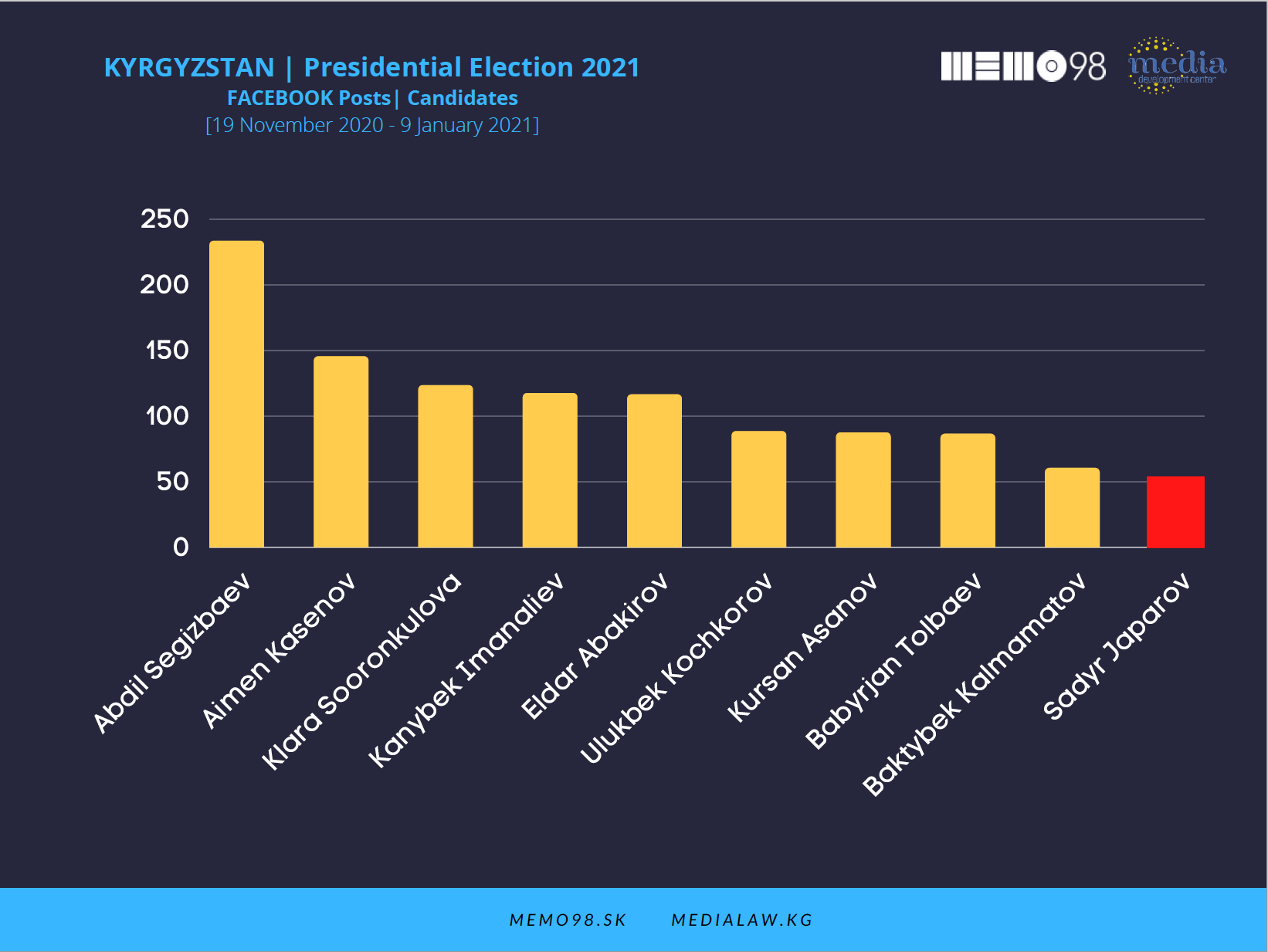
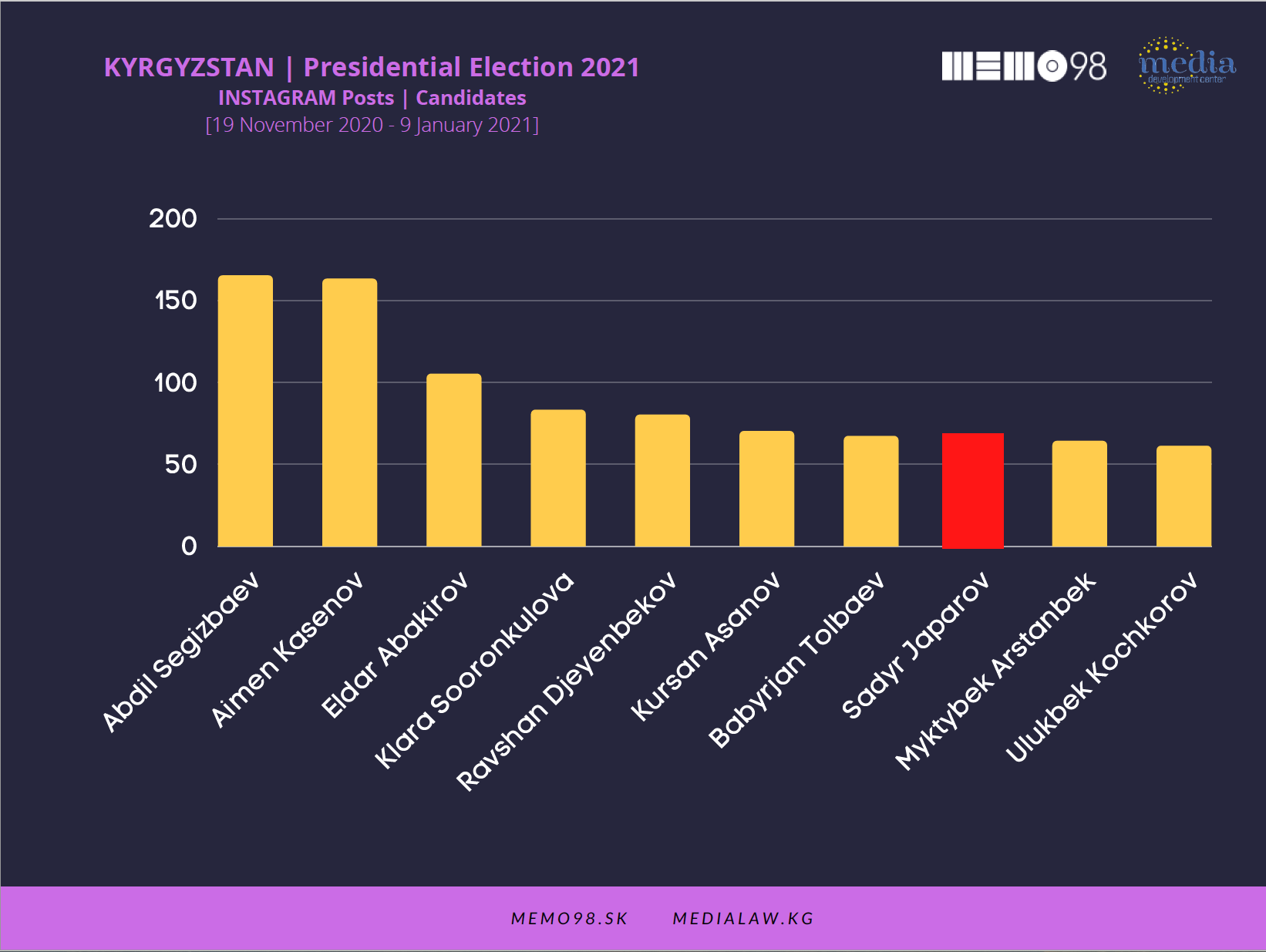
Posts of Abdil Segizbaev attracted the highest number of candidates-related interactions on Facebook (some 66,700), followed by Sadyr Japarov with as many as 59,500 interactions. As for Instagram posts, those of Aymen Kasenov were the most popular (some 152,500 interactions), followed by Myktybek Arstanbek with as many as 136,300 interactions, the only two candidates attracting over 100,000 interactions.

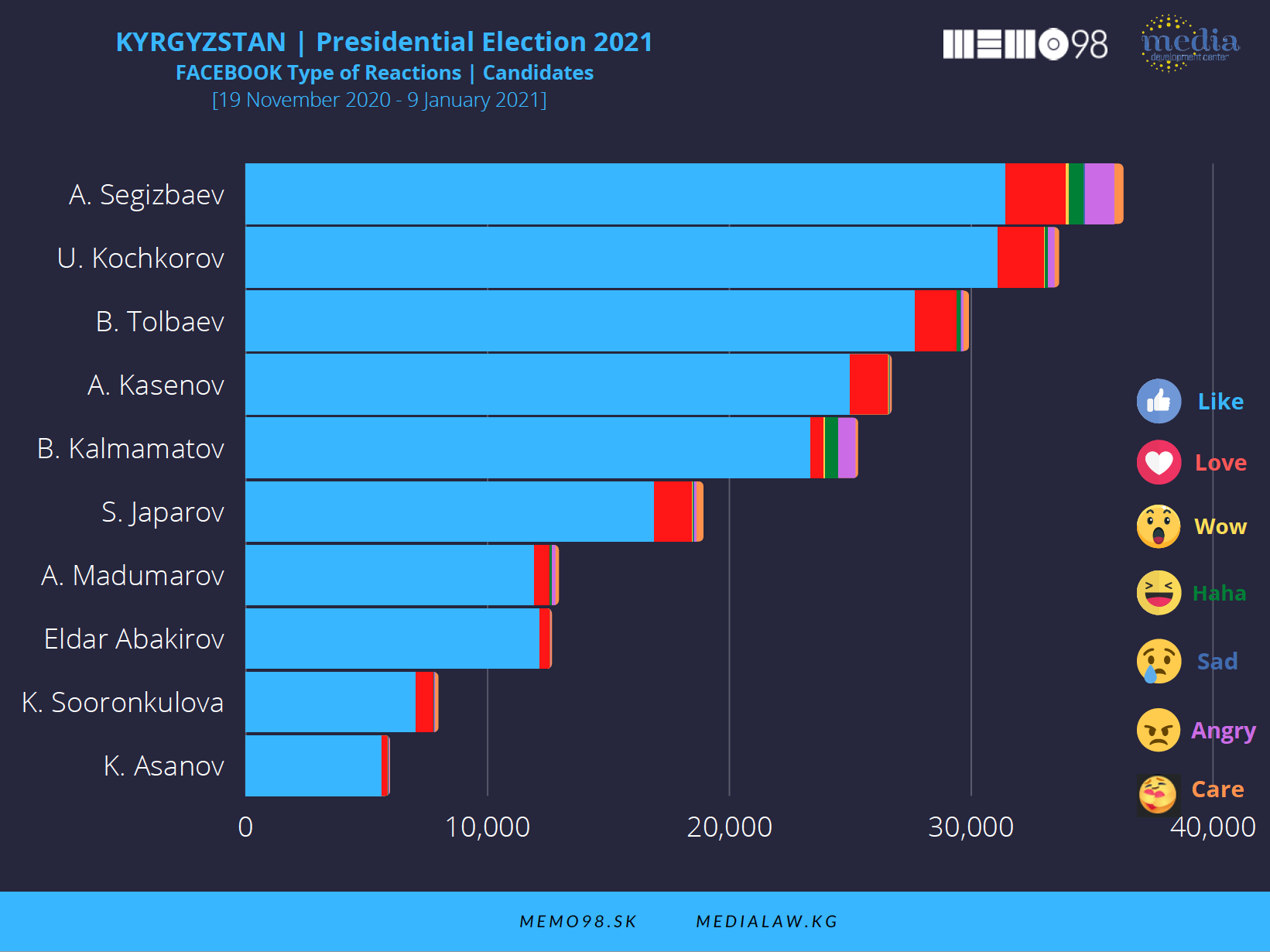
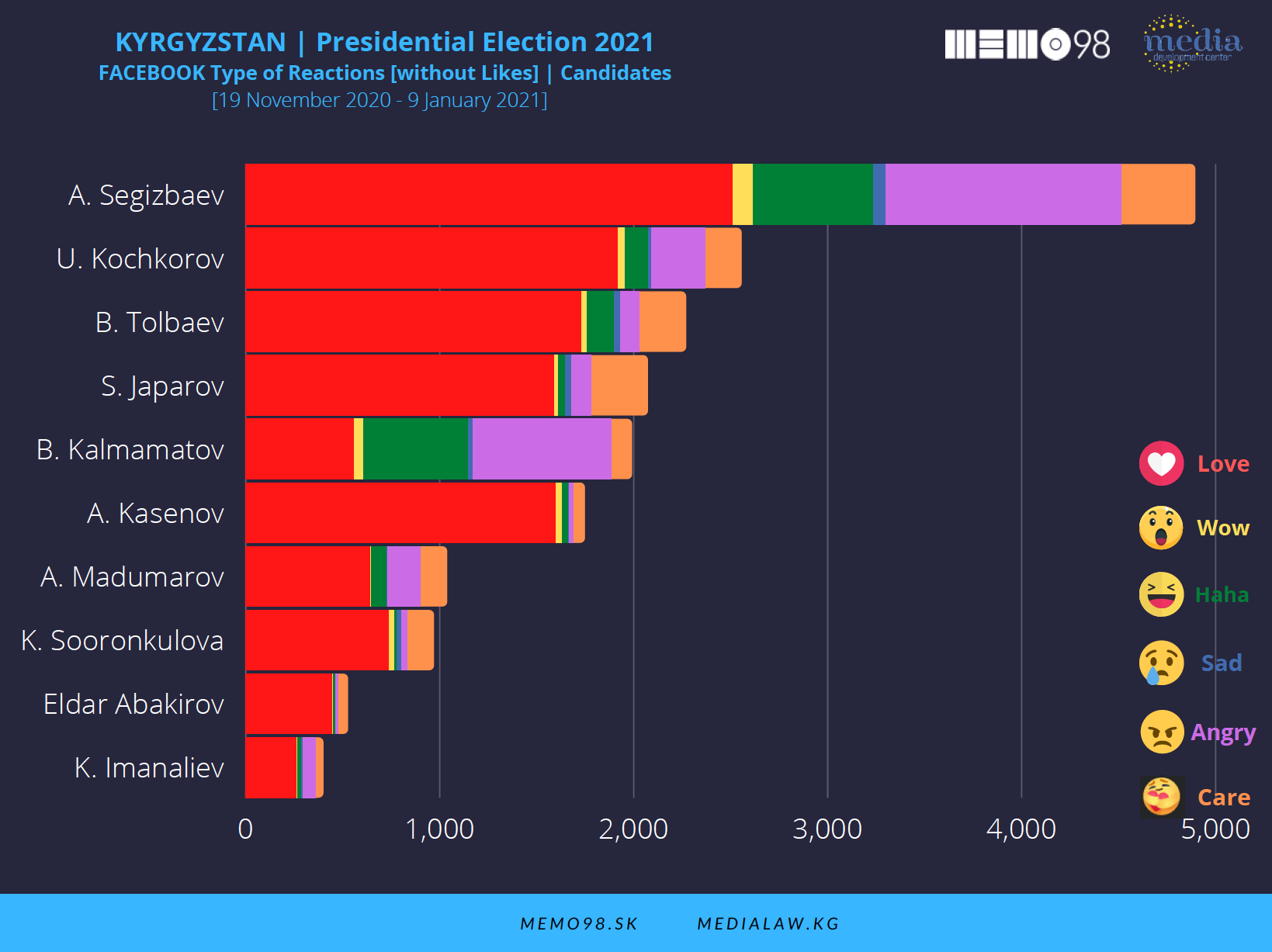
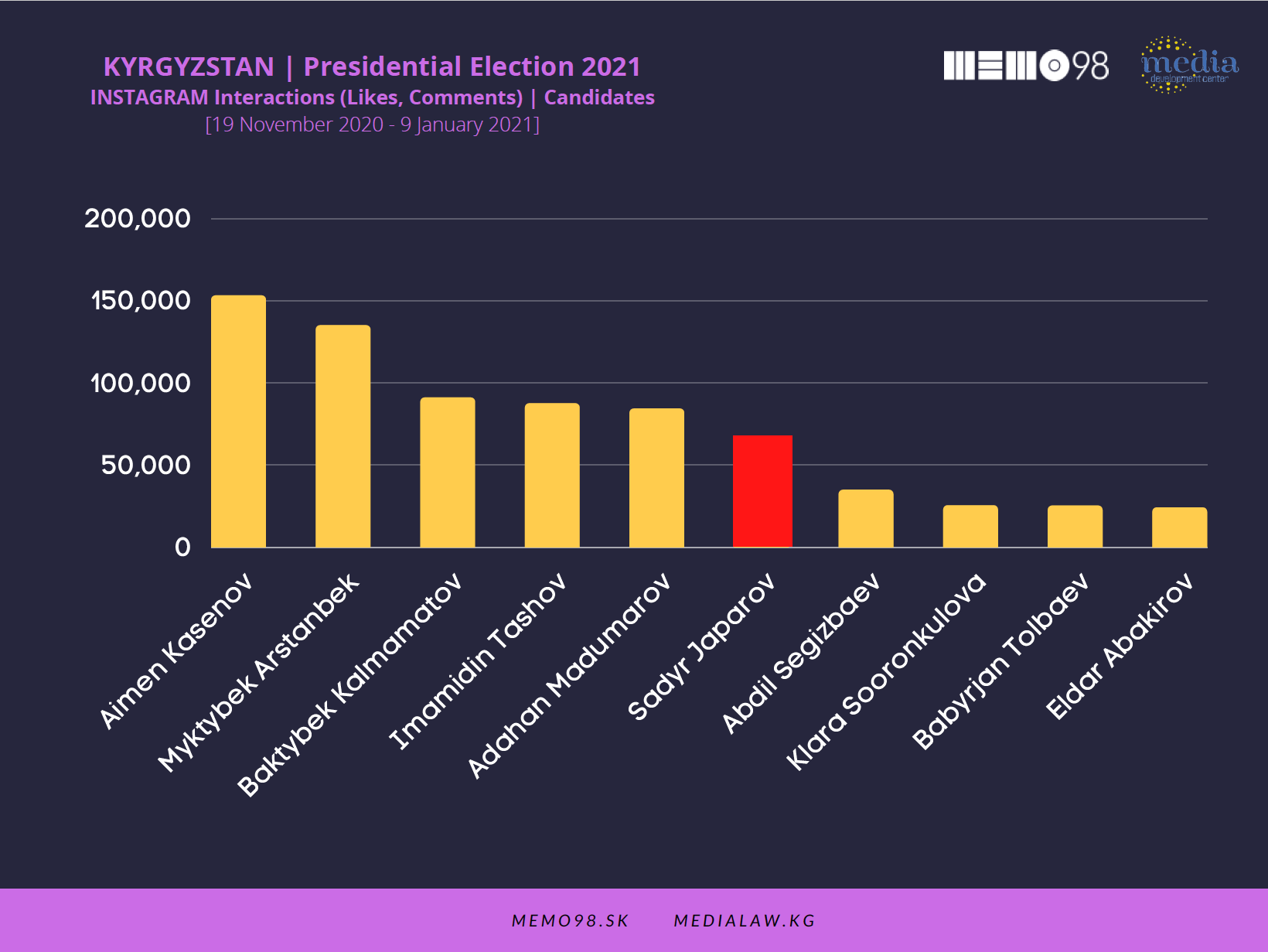
Among political parties, the Butun Kyrgyzstan produced the highest number of posts on Facebook - 23. It was followed by Reform (21 posts) and Chon Kazat (19 posts). Parties generated a smaller number of posts on Instagram (54 vs. 73 on Facebook), with Chon Kazat (34) and Reform (17) being the only parties One post throughout the whole period was produced by Mekenchil Party (the party has only a Facebook page).
Despite having a smaller number of posts, Chon Kazat’s activities, similarly as during the parliamentary elections, generated the highest number of interactions on Facebook (as many as 5,432), followed by the Reform party (2,389) and Butun Kyrgyzstan party (1,285). This was even more visible on Instagram, where Chon Kazat posts generated 25,917 reactions, while Reform and Butun Kyrgyzstan together received some 9,000 interactions.
The monitoring also focused on 15 official pages and accounts of traditional media, with 13 of them having a presence on both platforms. On Facebook, the online publication Kyrgyz Today was by far the most active (4,044 posts), followed by kg (1,875 posts) and Jetinchi TV (1,824 posts). On Instagram, the official account of Next TV was most prolific (1,364 posts), while four other media produced between 820 and 930 posts (Kaktus Media, News.kg, Azattyk, the Kyrgyz office of RFE/RL, and Sputnik, the Kyrgyz version of Russian state outlet). It should be noted that a number of posts on media accounts were not related to elections.
Eight media Facebook pages (out of 15 monitored) provided their online audiences with some coverage of presidential candidates. Jetinchi TV brought nearly as many posts about candidates (106) as all other media outlets together (113) – with Next TV and Azattyk being also fairly active. Campaign frontrunner Mr. Japarov dominated social media posting of all eight media outlets (in total with 163 posts out of 219 – some 75 percent). The media pages presented him mostly in a critical or neutral tone, however, the page of Jetinchi TV showed him primarily in a positive manner.
Instagram accounts of nine media (out of 14) covered presidential candidates, with kg, Next TV, and Azattyk being the most active ones (they presented 51 out of 72 total media posts about candidates). Sadyr Japarov was the most presented candidate on Instagram pages of six media (43 posts out of 72 – some 60 percent). While Kabarlar News showed him in an overwhelmingly positive tone, News.kg offered its readers the most critical coverage of Mr. Japarov.
When looking at the three important official Kyrgyz institutions, the Central Commission for Elections and Referenda (CCER) was the most active, in particular on Facebook (207 posts), followed by the Government (96 posts). On the contrary, officials used Instagram much less - they produced altogether 66 posts (divided equally between the CCER and the government) compared to 320 on Facebook.
Similar to the October parliamentary elections that took place against the backdrop of the Covid-19 pandemic, this topic was regularly present also prior to the presidential election. Nevertheless, political matters (election, referendum) dominated the campaign alongside personalized addresses of contestants, with some attention to the economy, education, and culture.
While most presidential candidates appeared to use advertising on the Facebook-owned platforms (at least 13), only three of them spent higher amounts of funds – Babyrkan Tolbav, Aimen Kasenov, and Kursan Asanov (all around 2,000 USD). At the same time, Eldar Abakirov promoted the highest number of ads among candidates (74) using a smaller aggregated amount of funds (some 950 USD). Victorious candidate Sadyr Japarov did not use a paid promotion at all. The total amount spent by various actors prior to the presidential election (around 16,000 USD, for some 1,740 ads) was significantly smaller in comparison with the online advertising prior to the October parliamentary elections (62,700 USD).
Cases of disinformation, inauthentic behavior, and inflammatory language were noted in social media during the campaign period. Problematic content was noted in particular on Facebook groups supporting Sadyr Japarov. There is an absence of legal provisions regulating disinformation or hate speech on social media (the Bill on Manipulating Information was halted by the President in summer 2020). A need to introduce realistic self-regulatory mechanisms and digital media literacy programs in the online space is even more urgent after the 2021 election.
The full report in English is available here and in Russian here.